This article was co-authored by wikiHow staff writer, Jennifer Mueller, JD. Jennifer Mueller is a wikiHow Content Creator. She specializes in reviewing, fact-checking, and evaluating wikiHow's content to ensure thoroughness and accuracy. Jennifer holds a JD from Indiana University Maurer School of Law in 2006.
There are 11 references cited in this article, which can be found at the bottom of the page.
This article has been viewed 63,093 times.
Learn more...
If you're writing a research paper or report in the medical sciences, you may need to reference Lexi-Comp. This online database provides up-to-date information on prescription drugs, as well as modules that cover an extensive range of medical topics.[1] The specific format for your citation will differ depending on the citation style you're using. In the medical sciences, the American Medical Association (AMA), American Psychological Association (APA), National Library of Medicine (NLM) and Vancouver styles are the most common citation formats.
Steps
Sample Citations
AMA
-
1Start with the name of the document itself and the specific database. Use the full name or title of the monograph, topic, or chart you accessed through Lexicomp. Place a period after the name, then identify the specific database where that document is located. Place a period after the name of the database.[2]
- Example: Etanercept. Lexi-Drugs.
-
2Identify the publisher and location. Lexicomp is published and maintained by Wolters Kluwer Health, Inc., which is located in Riverwoods, IL. Place this information after the name of the specific database, separated by periods.[3]
- Example: Etanercept. Lexi-Drugs. Lexicomp. Wolters Kluwer Health, Inc. Riverwoods, IL.
Advertisement -
3Provide a URL for Lexicomp. Following the publisher information, give the URL for the main page of Lexicomp. Since the direct URL for the page you accessed is generated as a result of your specific search, it should not be included. It will only direct your readers to an error page. If they want to pull up the page, they'll have to conduct their own search. Include the introductory phrase "Available at" so your readers know it is not a direct URL to the page itself. Place a period after the URL.[4]
- Example: Etanercept. Lexi-Drugs. Lexicomp. Wolters Kluwer Health, Inc. Riverwoods, IL. Available at: http://online.lexi.com.
-
4Close your citation with the date you accessed the document. Documents and information on Lexicomp are updated regularly. Including the date you accessed the information allows your readers to separate any later updates from the information you used. Type the word "Accessed" followed by the date in month-day-year format. Place a period after the date.[5]
- Example: Etanercept. Lexi-Drugs. Lexicomp. Wolters Kluwer Health, Inc. Riverwoods, IL. Available at: http://online.lexi.com. Accessed August 24, 2018.
-
5Use superscript numbers for in-text references. When using AMA style, citations in your references are listed when the first reference appears in the body of your paper. Each citation is numbered in your reference list. That same number is used throughout your paper whenever you mention the source again.[6]
- Reference list example: 2. Etanercept. Lexi-Drugs. Lexicomp. Wolters Kluwer Health, Inc. Riverwoods, IL. Available at: http://online.lexi.com. Accessed August 24, 2018.
- In text example: Etanercept is most commonly used to treat several forms of moderate to severe arthritis.2
APA
-
1Omit databases from your reference list. In general, APA doesn't require you to include citations to databases, such as Lexicomp, in your reference list. Since the information changes constantly, your readers won't necessarily be able to access the same information you did.[7]
- Rather than including a citation in your reference list, you would simply name the database in a parenthetical, along with the year you accessed it. For example: Etanercept is effective in the treatment of rheumatoid arthritis (Lexicomp, 2018).
-
2Use "Lexicomp" as the author if creating a reference list entry. If you do include a citation to Lexicomp in your reference list, you would cite the database or mobile app as a whole, rather than citing individual pages. Essentially, treat the whole thing as a book written by "Lexicomp." The specific entries you accessed would be treated like pages in a book.[8]
- Example: Lexicomp.
-
3Provide the year of the last update in parentheses. For the publication year, list the year the information on Lexicomp was last updated. In most cases, this will be the year you accessed the database. Place a period after your closing parentheses.[9]
- Example: Lexicomp (2018).
-
4List the title and a description of the database used. Following the year, type the title of the database. If the database has a proprietary capitalization system, use that. Otherwise, capitalize only the first word and all proper nouns. Include a phrase in brackets to tell your readers what kind of database it is. Place a period outside the closing bracket.[10]
- Example: Lexicomp (2018). Lexi-CLINICAL SUITE [Mobile application software].
- If there is a version number, include that in parentheses before the brackets. For example: Lexicomp (2018). Lexi-CLINICAL SUITE (Version 1.17.32) [Mobile application software].
-
5Close with an access statement. After you've identified the database you used, let your readers know how to access that database. In the case of a mobile application, you would use the URL where the app can be downloaded.[11]
- Example: Lexicomp (2018). Lexi-CLINICAL SUITE [Mobile application software]. Retrieved from http://webstore.lexi.com/Store/Bundled-Software-Packages/
-
6Follow author-date format for in-text parenthetical citations. Even if you don't have a citation in your reference list, you still need to provide a parenthetical citation in the body of your paper. This lets your readers know that you got the information somewhere else. Use "Lexicomp" as the author, and the date the page was last updated as the date.[12]
- Example: (Lexicomp, 2018).
NLM
-
1Start with the name of the specific page and database. For an NLM citation to Lexicomp, the name of the drug you looked up is the first part of your full citation. Place a period after the name of the drug. Since Lexicomp includes many different databases, provide the name of the specific database you used after the name of the page. Place a period after the name of the database.[13]
- Example: Etanercept. Lexi-Drugs.
-
2Include publication and access dates in square brackets. The next element of an NLM citation is typically the publication date. For databases, such as Lexicomp, that are constantly updated, provide the date last updated followed by the date you cited the entry. Separate the dates with a semi-colon, and use year-month-day format. Express the month with a 3-letter abbreviation.[14]
- Example: Etanercept. Lexi-Drugs. [updated 2018 Jul 6; cited 2018 Jul 9]
-
3Identify the general resource where you accessed the information. Type the word "In," then provide the full name of Lexicomp itself, along with the word "Internet" in square brackets. Place a period after the closing bracket.[15]
- Example: Etanercept. Lexi-Drugs. [updated 2018 Jul 6; cited 2018 Jul 9] In Lexicomp Online [Internet].
-
4Include the location and name of the publisher. For the next part of your citation, provide the city and state where Lexicomp is published and maintained. Type a colon, then list the name of the company that publishes and maintains Lexicomp. Place a period at the end of the name.[16]
- Example: Etanercept. Lexi-Drugs. [updated 2018 Jul 6; cited 2018 Jul 9] In Lexicomp Online [Internet]. Hudson, Ohio: Wolters Kluwer Clinical Drug Information, Inc.
-
5Close with a URL for the resource. When you look up a drug or other topic on Lexicomp, the URL generated is unique to your search and cannot be used later to access the same page. Therefore, your citation should provide a URL for the Lexicomp home page. Introduce the URL with the phrase "Available from" so your readers know the URL is not a direct link to the page you accessed.[17]
- Example: Etanercept. Lexi-Drugs. [updated 2018 Jul 6; cited 2018 Jul 9] In Lexicomp Online [Internet]. Hudson, Ohio: Wolters Kluwer Clinical Drug Information, Inc. Available from http://online.lexi.com/lco/action/home
-
6Follow the recommended format for in-text citations. The NLM itself does not have a specific style for in-text citations. Typically it is up to your instructor or supervisor to let you know which method of in-text citation they prefer. There are 3 basic methods to choose from.[18]
- Citation-sequence (AMA style): Citations in references are listed in order of their appearance in the text. Superscript numbers are used in-text to point to the full citation in the reference list.
- Citation-name: This in-text citation format uses superscript numbers as in AMA style, but the items in the reference list are listed alphabetically. The number associated with the particular reference never changes throughout your paper.
- Name-year (APA style): Your reference list is in alphabetical order, typically by the last name of the author. Since NLM citations place the page name first, you would use the page name (in quotation marks) followed by the year the page was last updated. For example: ("Etanercept," 2018).
Vancouver
-
1Start with the drug name and the specific database. Type the name of the drug you looked up, followed by a period. Type the word "In" followed by a colon, then name the specific database you used on Lexicomp. Use sentence-case, capitalizing only the initial word. Include the words "database on the Internet" in square brackets. Place a period after the closing bracket.[19]
- Example: Etanercept. In: Lexi-drugs online [database on the Internet].
-
2Provide the location and name of the publisher. Include the city where the company that produces and maintains Lexicomp is located, followed by the postal abbreviation for the state in parentheses. Place a colon after the location, then identify the name of the company. Place a colon after the name of the company.[20]
- Example: Etanercept. In: Lexi-drugs online [database on the Internet]. Hudson (OH): Wolters Kluwer Clinical Drug Information, Inc.:
-
3Include publication and citation dates. The year of publication is the year the database was most recently updated. Typically this will be the year you accessed the database. In brackets after the year of publication, include the date the specific page was last updated and the date you cited it. Use day-month-year format, and separate the dates with a semi-colon. Place a period after the closing bracket.[21]
- Example: Etanercept. In: Lexi-drugs online [database on the Internet]. Hudson (OH): Wolters Kluwer Clinical Drug Information, Inc.: 2018 [updated 6 July 2018; cited 9 July 2018].
-
4Copy the URL for the Lexicomp home page. Individual pages on Lexicomp do not have permalinks. Since you can't link directly to the page, provide a URL for the home page after the words "Available from." These words indicate to your readers that they will have to search for the drug themselves. Place a period after the URL.[22]
- Example: Etanercept. In: Lexi-drugs online [database on the Internet]. Hudson (OH): Wolters Kluwer Clinical Drug Information, Inc.: 2018 [updated 6 July 2018; cited 9 July 2018]. Available from: http://online.lexi.com.
-
5Add a disclaimer to indicate the database is not freely available. You can only access Lexicomp with a subscription to the service. If using the Vancouver citation style, you must let your readers know that the resource is not available without a subscription.[23]
- Example: Etanercept. In: Lexi-drugs online [database on the Internet]. Hudson (OH): Wolters Kluwer Clinical Drug Information, Inc.: 2018 [updated 6 July 2018; cited 9 July 2018]. Available from: http://online.lexi.com. Subscription required to view.
-
6Use superscript numbers to refer to the citation in text. In your reference list, your citations are numbered consecutively in the order in which they appear in your text. After you've mentioned the reference once, use the same original number for subsequent in-text citations.[24]
- Reference list example: 4. Etanercept. In: Lexi-drugs online [database on the Internet]. Hudson (OH): Wolters Kluwer Clinical Drug Information, Inc.: 2018 [updated 6 July 2018; cited 9 July 2018]. Available from: http://online.lexi.com. Subscription required to view.
- In-text example: Etanercept is an effective treatment option for patients suffering from moderate to severe rheumatoid arthritis.4
References
- ↑ https://www.ncbi.nlm.nih.gov/pmc/articles/PMC7064701/
- ↑ http://guides.lib.purdue.edu/c.php?g=352750&p=2377853
- ↑ http://guides.lib.purdue.edu/c.php?g=352750&p=2377853
- ↑ http://guides.lib.purdue.edu/c.php?g=352750&p=2377853
- ↑ http://guides.lib.purdue.edu/c.php?g=352750&p=2377853
- ↑ https://guides.lib.uw.edu/c.php?g=99161&p=642357
- ↑ https://owl.purdue.edu/owl/research_and_citation/apa_style/apa_formatting_and_style_guide/reference_list_electronic_sources.html
- ↑ https://libguides.css.edu/c.php?g=41681&p=265029
- ↑ https://libguides.css.edu/c.php?g=41681&p=265029
- ↑ https://libguides.css.edu/c.php?g=41681&p=265029
- ↑ https://libguides.usc.edu/APA7th/articles
- ↑ https://library.georgiancollege.ca/citing/specialty-lp
- ↑ http://libraryguides.neomed.edu/citing/nlm
- ↑ http://libraryguides.neomed.edu/citing/nlm
- ↑ http://libraryguides.neomed.edu/citing/nlm
- ↑ http://libraryguides.neomed.edu/citing/nlm
- ↑ http://libraryguides.neomed.edu/citing/nlm
- ↑ https://musc.libguides.com/NLM/intext#loaded
- ↑ https://libraryservices.acphs.edu/c.php?g=636517&p=4453501
- ↑ https://libraryservices.acphs.edu/c.php?g=636517&p=4453501
- ↑ https://libraryservices.acphs.edu/c.php?g=636517&p=4453501
- ↑ https://libraryservices.acphs.edu/c.php?g=636517&p=4453501
- ↑ https://libraryservices.acphs.edu/c.php?g=636517&p=4453501
- ↑ https://libguides.murdoch.edu.au/Vancouver/text
About This Article
Lexicomp can be a great addition to a research paper, and it’s easy to cite. To make an in-text citation for Lexicomp in APA format, put "Lexicomp" followed by a comma and the current year in parenthesis. On your reference sheet, write “Lexicomp” followed by the current year in parenthesis and a period. Then, list the title and a description of the database you used to access it. Finally write, “Retrieved from” followed by the URL. To learn how to cite Lexicomp in AMA format, read on!
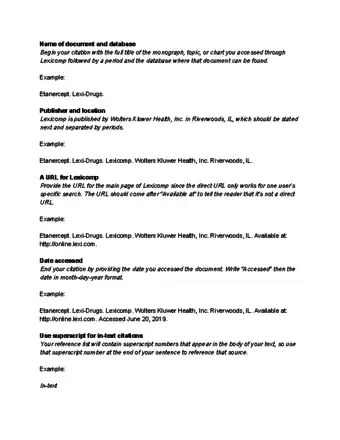
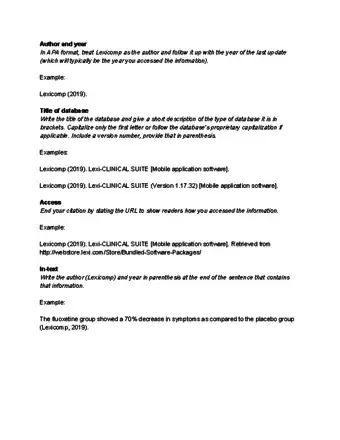
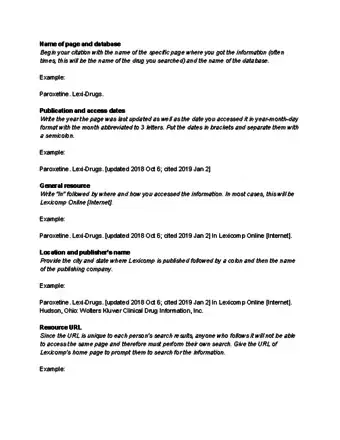
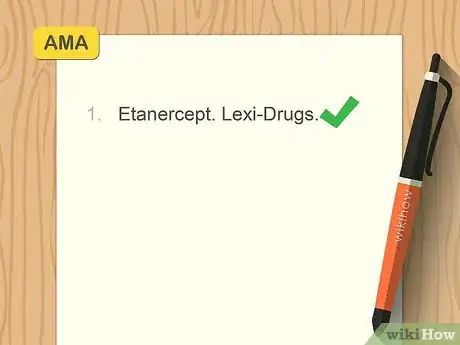
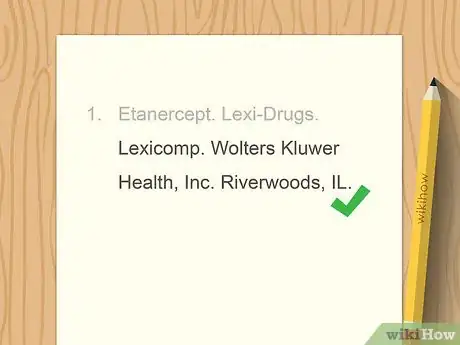
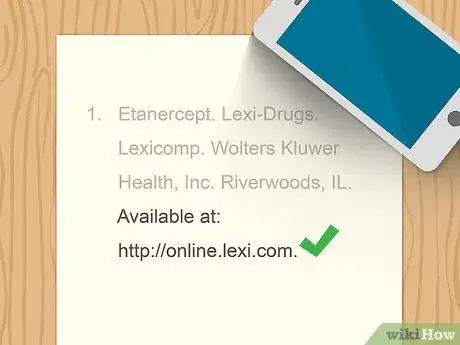
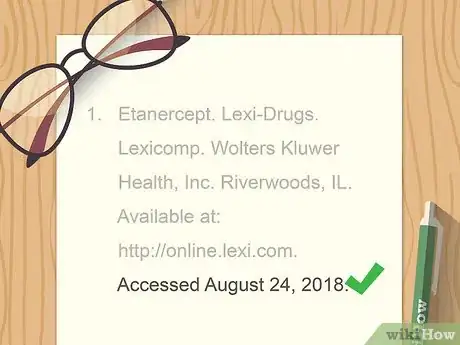
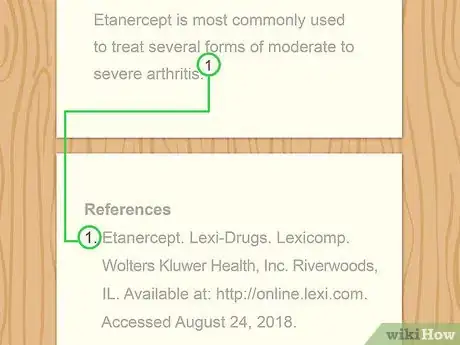

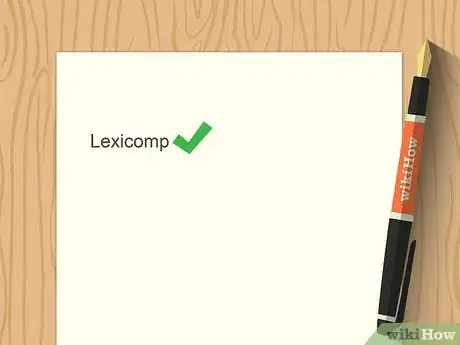
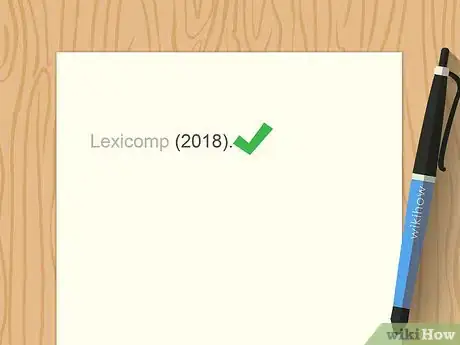
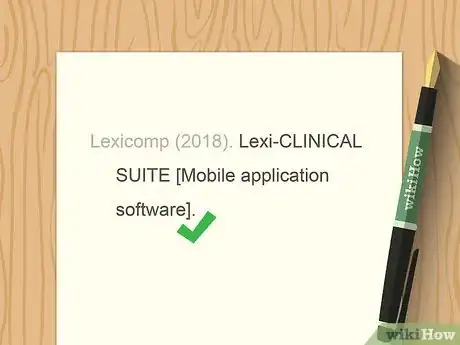
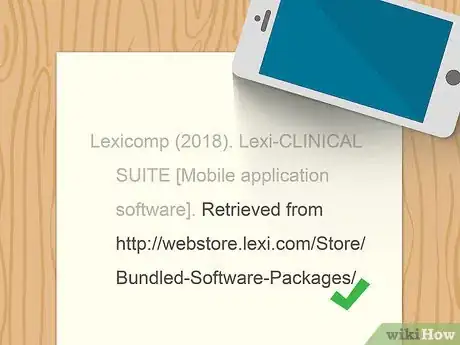

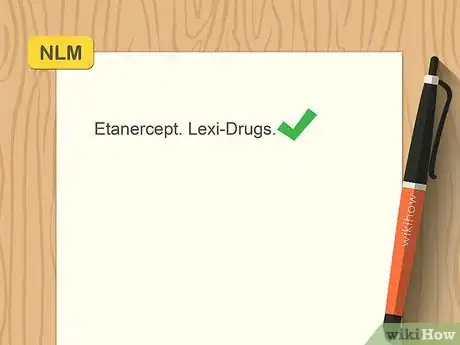
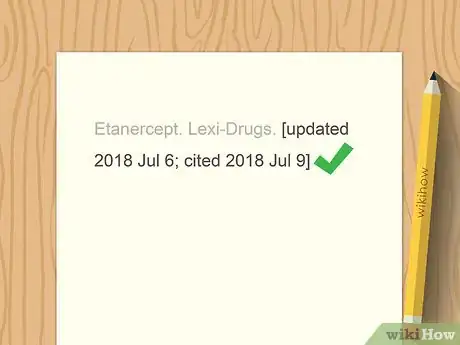
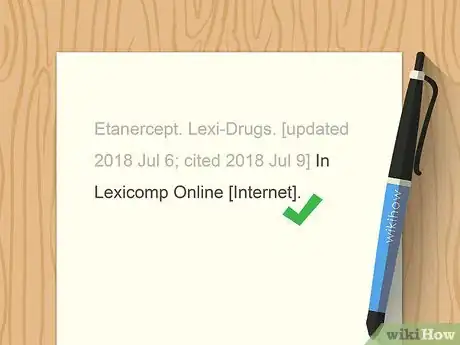
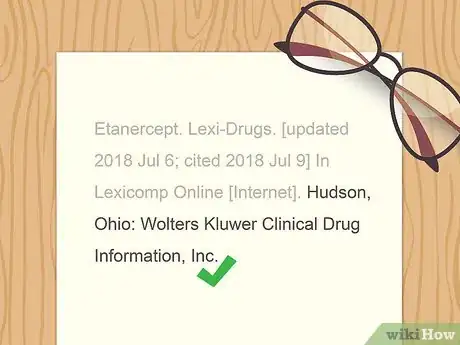
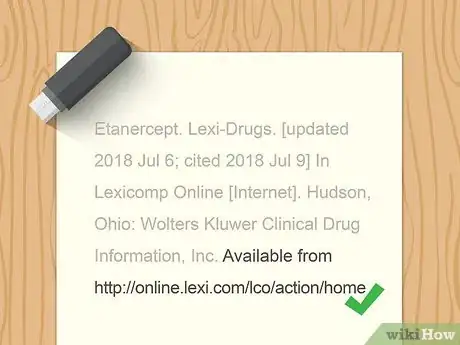

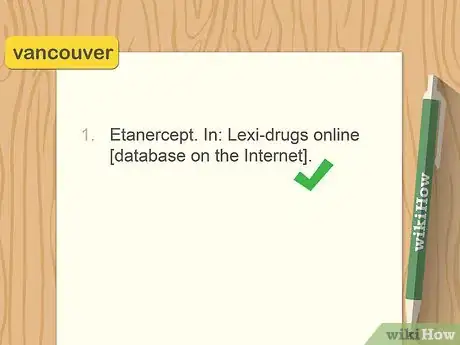
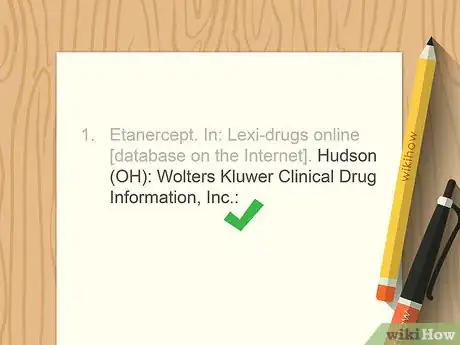
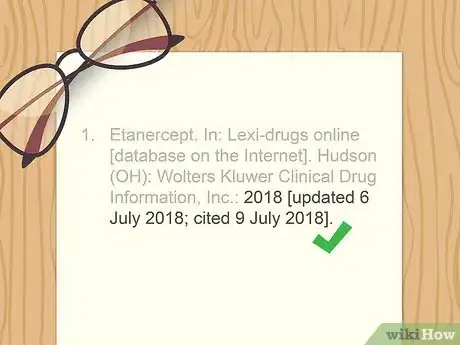
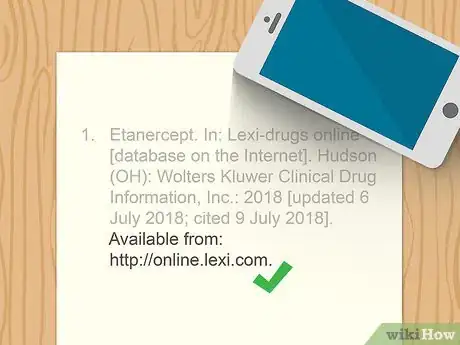
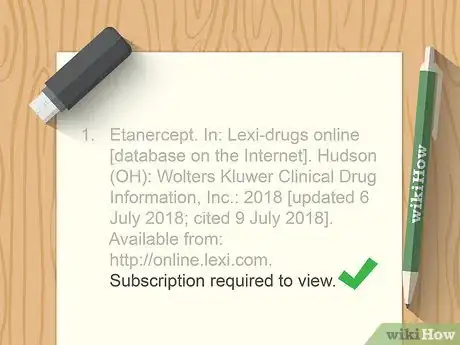
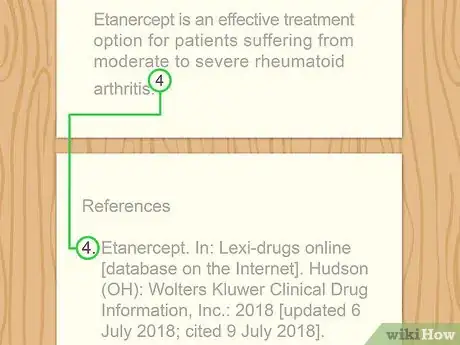
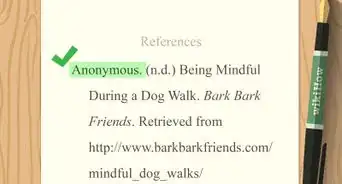








-Step-18.webp)

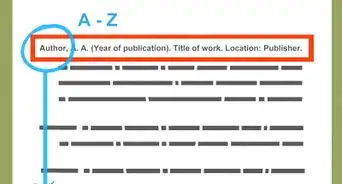
















































Medical Disclaimer
The content of this article is not intended to be a substitute for professional medical advice, examination, diagnosis, or treatment. You should always contact your doctor or other qualified healthcare professional before starting, changing, or stopping any kind of health treatment.
Read More...